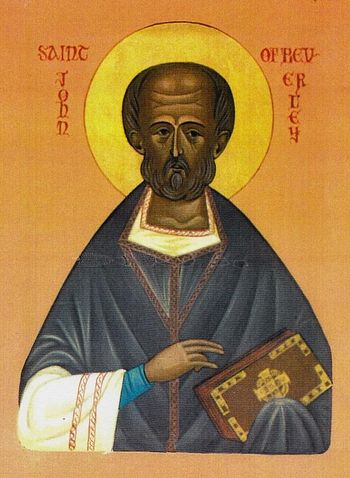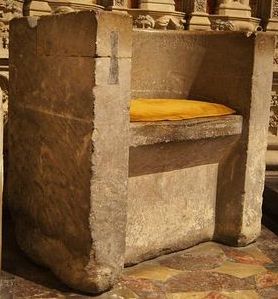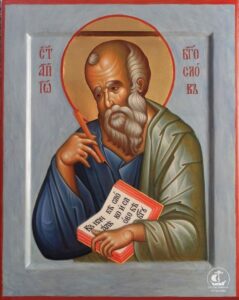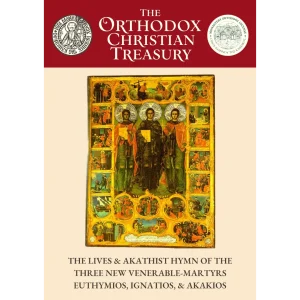SAINT JOHN OF BEVERLEY, BISHOP OF YORK

by Dr. Vladimir Moss
Our holy Father John was born of noble parents at Harpham, Yorkshire in 640. As a youth he studied the Holy Scriptures, Church music, Greek and Latin in the famous school of Saint Adrian at Canterbury, and then under Abbess Enfleda at the double monastery at Whitby. After leaving the monastery, he used his great rhetorical gifts as a missionary to the unenlightened English. He was also endowed with the gift of healing. On August 25, 687, John was consecrated bishop of Hexham in succession to Bishop Eata. Among the people, he ordained during this period was the Venerable Bede, whom he raised to the diaconate in 692 and to the priesthood in 703. During fast periods he would retire to a quiet house set among trees with a church dedicated to the Archangel Michael. It is now called St. John’s Lee. Here he continued his holy life and the working of miracles. Thus the following miracle was related by Abbot Herebald, one of the bishop’s clergy: “When in the prime of my youth I lived among his clergy, applying myself to reading and singing, but not having altogether withdrawn my heart from youthful pleasures, we came into a plain and open road, well adapted for galloping our horses. The young men that were with him, and particularly those of the laity, began to entreat the bishop to allow them to gallop, and make trial of the goodness of their horses. He at first refused, saying that it was an idle request. But finally, being prevailed upon by all, he said: ‘Do so if you want, but let Herebald have no part in the trial.’ I earnestly prayed that I might have leave to ride with the rest, for I relied on an excellent horse, which he had given me, but I could not obtain my request. “When they had galloped backwards and forwards several times, with the bishop and I looking on, my wanton humour prevailed, and I could no longer refrain, and in spite of his refusal I joined the rest and began to ride at full speed; at which I heard him call after me: ‘Alas! how much you grieve me by riding like that!’ Although I heard him, I continued against his command. But as the fiery horse leapt over a hollow, I fell motionless and lost consciousness, as if dead. For there was a stone in that place covered with turf, the only stone in the whole plain. And it happened, as a punishment for my disobedience.., that my head and hand, which in falling I had clapped to my head, hit the stone, so that my thumb was broken and my skull cracked and I lay, as I said, as one dead. “And since I could not move, they stretched a canopy for me to lie in. It was about the seventh hour of the day, and having lain still, and as it were dead from that time till the evening, I then revived a little, and was carried home by my companions, but lay speechless all night, vomiting blood, because something had been broken inside me by the fall. The bishop was very grieved at my misfortune, and expected my death, for he had an extraordinary affection for me. Nor would he stay that night, as was his habit, among his clergy; but spent it all only in watching and prayer, imploring the Divine goodness, as I imagine, for my health. Coming to me early in the morning, and having said a prayer over me, he called me by my name, and as it were waking me out of a heavy sleep, asked whether I knew who it was who was speaking with me. I opened my eyes and said: ‘I do; you are my beloved bishop.’ ‘Can you live?’ he said. I answered: ‘I may, through your prayers, if the Lord wills.’ “He then laid his hand on my head, blessed me, and returned to prayer. When he came to see me again a little later, he found me sitting and able to talk; and, moved by a Divine instinct, began to ask me whether I knew for certain that I had been baptized. I answered: ‘I know for certain that I have been washed in the laver of salvation, for the remission of my sins.’ And I named the priest by who I knew that I had been baptized. He replied: ‘If you were baptized by that priest, your baptism is not perfect; for I know him, and I know that because of his lack of intelligence he was unable to learn the ministry of catechism and baptism; which is why I ordered him to desist from his presumptuous exercise of his ministry, which he could not duly perform.’ Having said this, he took care to catechise me at that very time. Then he blew on my face, and I felt better. He called the surgeon and ordered him to close and bind up my skull where it was cracked. And, having received his blessing, I was so much better that the next day I mounted on horseback and travelled with him to another place. And when, a little later, I had completely recovered, I received the baptism of life.” In 705, on the death of Bishop Bosa, St. John became bishop of York. Once, at the beginning of Great Lent, he healed a dumb man who used to come to him for alms by simply making the sign of the cross on his tongue. Another time, he healed a nun at the monastery of Wetadun (probably Watton) by praying over her. Once the bishop went to consecrate a church and was urged to eat with a local nobleman named Earl Puch whose wife was sick. St. John sent one of the monks to the woman with some holy water that he had blessed for the consecration. After washing herself in the water, the woman rose from her sickbed and immediately, like the Apostle Peter’s mother-in-law, served the bishop and her husband at table. Again, the bishop went to consecrate the church of Earl Addi at Cherry Burton. After the service, Addi asked him to visit his servant, who was lying mortally ill. The bishop saw the dying man with the coffin at his side and all those present weeping. Then he said a prayer, blessed him and said: “May you soon recover”. Later, the servant asked his lord for a cup of wine, and the earl sent him a cup blessed by the bishop. Immediately he drank of it, he was cured and joined the earl and the bishop at the table. Once the bishop was present at a great council of King Osred of Northumbria and his nobles. After the council, he was invited to a meal by the king; and during the meal St. John ordered three jars to be filled, one with wine, one with mead, and one with beer. After the bishop had blessed the jars, they were found to be inexhaustible, recalling the miracles of the Lord Himself at Cana and in the feeding of the five thousand. Then King Osred called Brithred the butler to him and congratulated him, saying: “Now we have been convinced of the sanctity of your lord by the virtue which we see”. Once during his travels St. John came to a beautiful spot in “a land of wild forests and waters, in the midst of which stood a church dedicated to St. John the Divine.” From the nearby stream which abounded in beavers, it was known as Beverley, “beaver stream”. Here Bishop John bought some land, enlarged and beautified the church, and made it into a double monastery which he richly endowed. Once St. John came to the monastery at Beverley, as Abbot Brihtun tells the tale. After the bishop had inspected the monastery and conducted long services, the abbot suggested that he have a bath. And after the bath, the abbot offered the bishop some wine. The bishop assented, and Brithred the butler was ordered to take the glass of wine to him. But Brithred carelessly left the flask hanging in an exposed place on the wall, and it fell down and it broke. Miraculously, however, the wine did not run out but remained within the broken pieces of the flask. The bishop liked to pray in the chapel of St. Martin in York, which was next to his house. While he was praying there, the Holy Spirit was seen hovering over his head in the form of a white dove. At the same time, a blinding light was seen coming out of the apertures of the church, which amazed all those who saw it. At length, St. John’s deacon, whose name was Sigga, unbolted the door, entered the church, and saw the majestic vision of the bishop praying with arms outstretched in a blinding light and with a snow-white dove hovering over his head. Immediately the skin of his face wrinkled up as if it had been boiled. Sensing that he was being watched, the saint turned round. Coming up to Sigga, he healed his face by a simple touch but warned him not to relate what he had seen during his lifetime. Great crowds of people would come to the bishop when he was performing the sacrament of Holy Unction. Once they brought a dead man up to him, and after the bishop had anointed him with the holy oil, he arose. The bishop similarly used to drive demons out of people and healed the sick wherever he found them. St. John resigned from his see in 717, consecrated his priest Wilfrid in his place, and retired to the monastery he had founded at Beverley. Four years later, on May 7, 721, he reposed and was buried in the porch of St. John the Theologian. Through his prayers, many miracles continued to be wrought at his tomb after his death: demons were expelled, the blind, the deaf, the mute, and the lame were healed, and all kinds of sorrows were removed. Before the great battle of Brunanburgh in 937, King Athelstan prayed at the shrine of St. John at Beverley. That night St. John appeared to him in his sleep and promised him victory. In gratitude, the king on returning from the battlefield endowed the church with many rich gifts. In 1037 St. John was canonized by Pope Benedict IX, and Aelfric, Archbishop of York, translated his remains to a more costly shrine sparkling with gold and precious stones. In 1065 Archbishop Ealdred of York commissioned the Monk Folcard of St. Bertin’s monastery near St. Omer in France to write verses in honour of St. John and then his life. Folcard relates many miracles of the saint. A blind boy brought from Hexham recovered his sight at his tomb. A Scot called Gillo, who was deformed, prayed on his own at the shrine of the saint on the eve of his feast and was healed. A criminal condemned to die repented. He invoked the help of St. John, and the chains fell from his arms. He went to Beverley and offered the chains to the shrine. A citizen of York had a favourite son who became dumb. He recovered when he was taken to Beverley Minster. The stone chair of St. John is still to be seen in Beverley Minster.

Later it became known as the “peace chair”, and was probably used by an official investigating the cases of fugitives seeking sanctuary in the church. During the Norman Conquest, a band of Normans marched into Beverley to pillage the shrine. Their leader, whose name was Toustain, seeing an old man dressed in gold bracelets, galloped towards him with his sword drawn. The old man fled, terrified, to the church. Toustain pursued him through the gates of the churchyard. But at that moment the horse slipped on the pavement and Toustain fell to the ground, stunned. The Normans regarded this as the wrath of St. John, and fled. Indeed, according to the twelfth-century writer John Brompton, the territory of St. John was the only land in the whole of the North of England which did not suffer from the depredations of the Normans. St. John’s shrine was probably destroyed by fire in 1188. But five years later his bones were discovered, and in 1308 the new shrine was completed. The relics were hidden during the Protestant Dissolution of the monasteries, but in 1604 they were found again in a case of lead. They were brought to light again when the nave was repaved in 1736, and are now interred in the Minster beneath a slab in the nave floor near the choir stalls. St. John is commemorated on May 7.
Holy Father John, pray to God for us!
(Sources: The Venerable Bede, History of the English Church and People; Folcard, Vita Sancti Johannis Episcopi Eboracensis; A. Thierry, A History of the Norman Conquest of England, London: J.M. Dent, vol. 1, pp. 215-216; Fr. Andrew Phillips, Orthodox Christianity and the English Tradition, English Orthodox Trust, 1995, chapter 81; David Farmer, The Oxford Dictionary of Saints, Oxford: The Clarendon Press, 1978, p. 216; Ivor R. Dowse, The Pilgrim Shrines of England, London: The Faith Press, 1963; Pamela Hopkins, St. John of Beverley, Beverley: Halgarth Publishing, 1999; Nick Mayhew Smith, Britain’s Holiest Places, Bristol: Lifestyle Press, 2011, pp. 358, 372-373)
Troparion tone 4
We acclaim thee, beloved Bishop John, righteous shepherd of souls, friend of the needy, healer of the sick, and pattern of monastic striving; O blessed adornment of Beverley, who wast invoked by kings and the lowly alike, we of these present times beseech thee, blessed father, entreat Christ God that we be granted great mercy.
Kontakion tone 5
Thou didst receive from heaven divine grace, O holy father John, and wast truly a vessel of light; wherefore it is meet for us to honour thee, revered hierarch, who by a sweet fragrance hast been revealed to us who now venerate thy memory and cry: Glory to God Who hath sanctified thee.







My medically incurable tinnitus was miraculously healed praying to St. John of Beverley on my way to Beverley to support someone resident there in a court case in 2005.